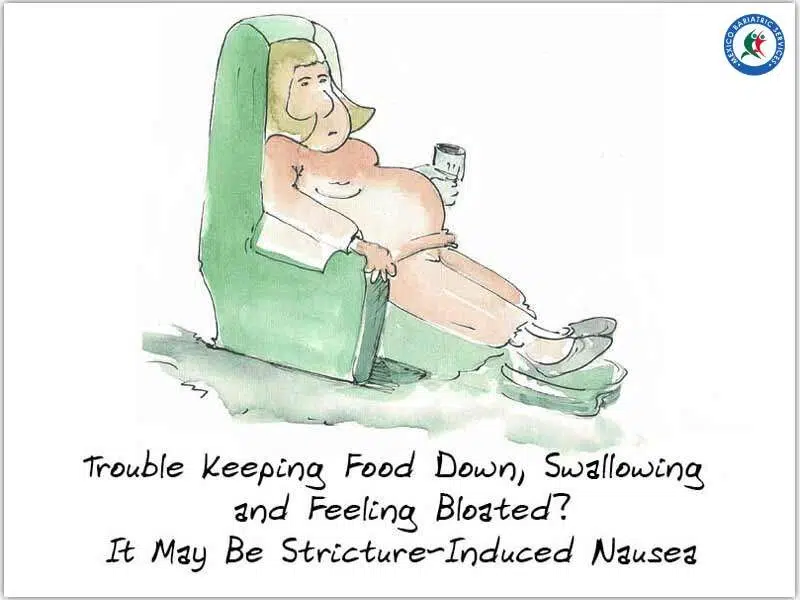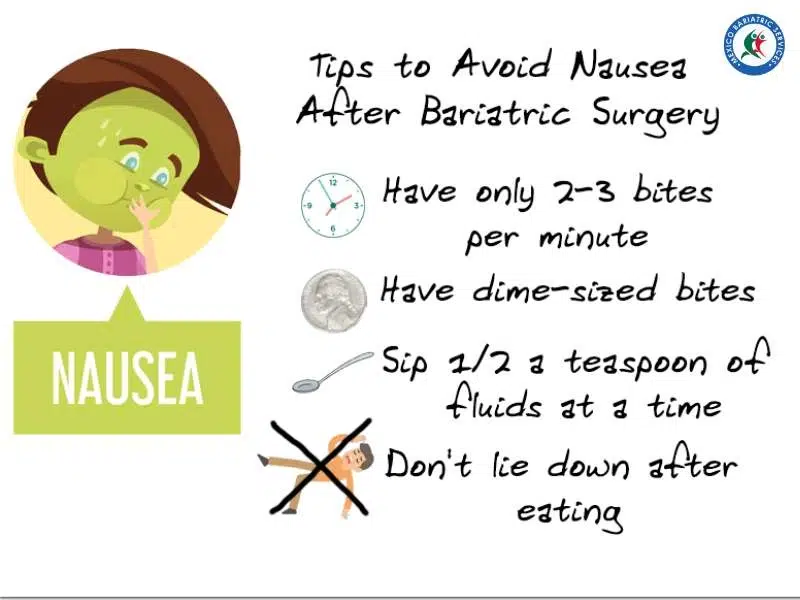Stricture Induced Nausea after Bariatric Surgery – What You Need to Know
Medically Reviewed by Katelyn J. Mock, US-Registered Dietician (R.D.)
A stricture or stenosis occurs when the opening of the new attachment between the stomach and small intestine becomes narrow, causing pain and nausea after bariatric surgery.

It can develop due to a multiplicity of factors, which include:
- Restricted blood flow to the concerned region
- Smoking or taking certain NSAIDs, such as aspirin, that result in ulcers
- Scars left by healing wounds
- Use of staples in place of stitches
- Bacterial infection in the stomach
Symptoms of a Stricture After Bariatric Surgery
- Growing intolerance toward food
- Vomiting/Throwing Up
- The problem in swallowing food (dysphagia)
- Abdominal fullness
Detection of Strictures After Bariatric Surgery
Where does a stricture occur?
According to a study, strictures occur in the following areas after a bariatric procedure [1]Hernández, Julián, and Camilo Boza. “Novel Treatments for Complications after Bariatric Surgery.” Annals of Surgical Innovation and Research10 (2016): 3. PMC. Web,
View in Article
- RnY Gastric Bypass – gastrojejunal anastomosis where a stricture begins to develop 3 to 4 weeks after surgery.
- Laparoscopic Sleeve Gastrectomy – gastric remnant where a stricture develops roughly 6 weeks after surgery.
How can a stricture be diagnosed?
To diagnose a stricture, the following tests may be performed:
- Upper gastrointestinal series
- Computed tomography
- Endoscopy
Treatment of Nausea and Strictures

To cure nausea, a permanent remedy for strictures is required, which is possible through the following methods:
- Intravenous fluids/Drips – prohibition of oral fluid or dietary intake is advised in case of strictures. The use of intravenous proton pump inhibitors helps in rehydration and controlling strictures/fistulas.
- Endoscopic dilation – In addition to traditional balloon dilation, Savary-Gillard dilators have been introduced to manage strictures. These, as per a study, resolve the condition in 75% of the cases. Endoscopic dilation is highly effective if performed early (within 90 days of the concerned bariatric surgery) and even prevents the need for revisional surgery.
- Self-expandable endoscopic stents – Stents made from either metal or polyester are placed to treat this complication by fostering the permeability of the gastrointestinal tract.
- Sleeve to Gastric Bypass Revision Surgery – In the case of long-term stenosis or chronic strictures, surgical intervention is required. A study[2]Sarkhosh, Kourosh et al. “Complications Associated with Laparoscopic Sleeve Gastrectomy for Morbid Obesity: A Surgeon’s Guide.” Canadian Journal of Surgery5 (2013): 347–352. PMC. Web,
View in the Article reveals that a conversion surgery from gastric sleeve to gastric bypass is the option generally available.
Tips to Manage Stenosis and Associated Nausea

- Do not indulge in smoking
- Use NSAIDs under the supervision of your healthcare provider
- Strictly follow the diet-related advice given by the bariatric surgeon
- Take more fluids. Here are some tips on how to stay hydrated after bariatric surgery.
- Know that treatment can have certain side effects, which may lead to further short-term nausea
The rate of occurrence of strictures is very low, especially with the advent of new scientific methods for bariatric surgery. Nevertheless, visit the doctor at the earliest, if you start experiencing post-bariatric surgery-related symptoms such as nausea.
References:
- Hernández, Julián, and Camilo Boza. “Novel Treatments for Complications after Bariatric Surgery.” Annals of Surgical Innovation and Research10 (2016): 3. PMC. Web,
- Sarkhosh, Kourosh et al. “Complications Associated with Laparoscopic Sleeve Gastrectomy for Morbid Obesity: A Surgeon’s Guide.” Canadian Journal of Surgery5 (2013): 347–352. PMC. Web,
This Post Addresses
- What Causes a Stricture After a Gastric Sleeve?
- Stomal Stenosis and Stricture Dilation After Gastric Bypass
- Esophageal and Anastomotic Stricture After Gastric Bypass
- Gastric Stricture Treatment

